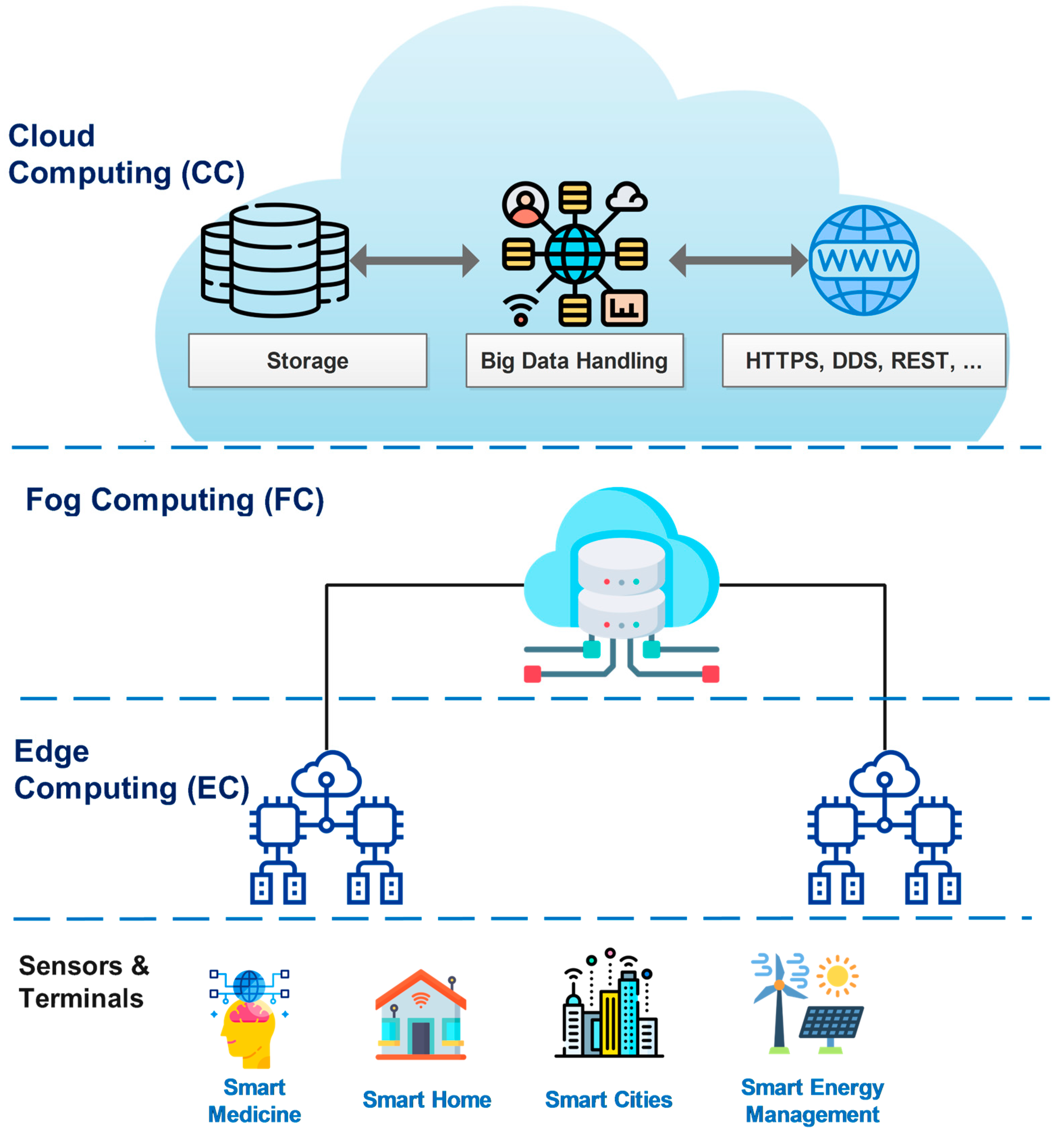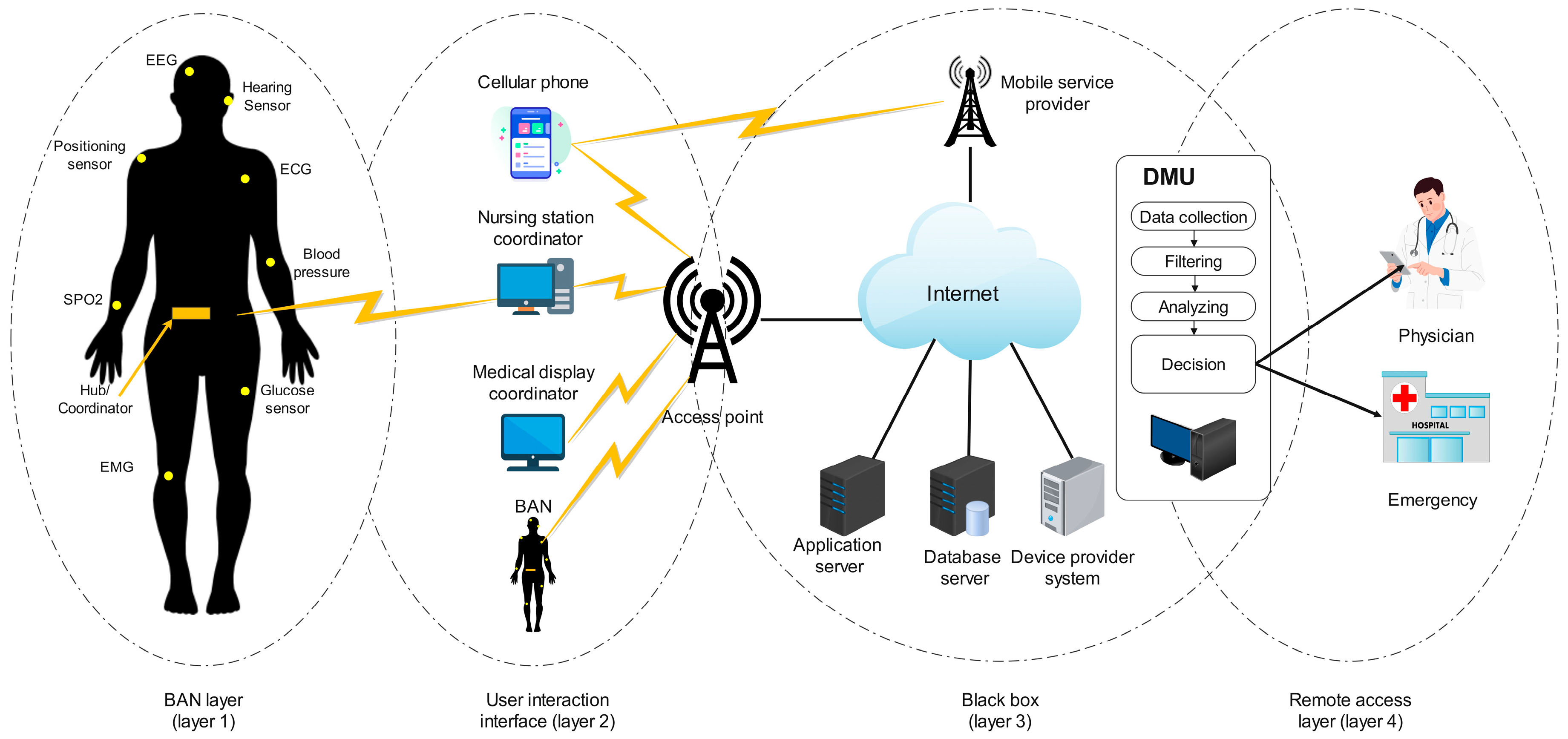You're using an outdated browser. Please upgrade to a modern browser for the best experience.
Please note this is a comparison between Version 2 by Conner Chen and Version 1 by Quy Khanh Vu.
Some advanced technologies and solutions have been researched, developed, and deployed in the smart healthcare field, such as smart sensors, autonomous devices, robots, intelligent computing solutions, and virtual reality.
- smart healthcare
- 6G
- Internet of Things
1. Smart Sensors
A smart sensor is a device that allows users to accurately and automatically collect data on physical and chemical changes in the area where the device is mounted. Intelligent sensors collect information with high accuracy.
Wearable sensors can be embedded in clothing, implanted in the body, or worn on the wrist. In smart healthcare, devices collect patients’ vitals and transmit them to calculation servers via wired or wireless network connections. Many wearable products have been focused on development in recent years [23][1], such as smartwatches, wristbands, eyewear, headphones, earplugs, body straps, and devices worn on the hands and feet, as presented in Figure 1. In [24[2][3],25], the authors indicate feasible solutions to the application of wearable medical sensors by using varying smartphone sensors to detect anomaly data in healthcare areas.

Figure 1.
An illustration of smart wearable healthcare sensors.
Sensors can be classified as wearable sensors, implantable sensors, etc. In the smart healthcare domain, wearables can be mainly used to measure and check patients’ activities and vitals to alert or provide data to healthcare systems from a distance. Some of the patient vitals that need to be monitored based on wearable sensors are as follows [26][4].
Pulse: A pulse sensor monitors the pulse in the human body, and can be used to monitor emergency conditions such as cardiac arrest and pulmonary embolism. The pulse signal can be installed in positions such as the wrist, earlobe, chest, fingertip, etc. Signals from the earlobe and fingertip locations are highly accurate, but placing the pulse sensors in these areas is difficult. Sensors placed in the wrist position are often more convenient and long-lasting.
Respiratory Rate: A respiratory rate sensor measures the respiratory rate, or the number of breaths of a patient per minute; it is used to monitor individuals with airway-related diseases such as asthma, lung cancer, respiratory failure, tuberculosis, etc.
Body Temperature: A body temperature sensor is used to measure a patient’s temperature. These sensors can read the appropriate temperature range to monitor the temperature of the human body. The accuracy of the body temperature sensor depends on the location of the human body.
Blood: A blood pressure sensor is used to measure a patient’s blood pressure (BP). High blood pressure is a risk factor for cardiovascular disease. However, the accuracy of a blood pressure sensor depends on its measurement location. Since there is no precise BP measurement, several modalities have been proposed whereby two PPG optical sensors are located at different positions on the patient’s arm.
Oxygen: An oxygen sensor measures the oxygen level in the blood. This is an important parameter to assist doctors in accurately diagnosing the amount of oxygen supplied to the body. However, due to the use of infrared LEDs, a major limitation of these sensors is their high power consumption. To solve this problem, measurement techniques based on the signal-to-noise ratio (SNR) and PLL [27][5] were proposed. The results showed that using this solution can save six times more energy than not using this solution.
Finally, the data collected from the sensors is transmitted to dedicated servers in different computing layers for processing, calculation, and storage to provide optimal intelligent medical services to patients.
2. Cloud, Fog, and Edge Computing
Cloud computing (CC) has existed for decades. One of the key unique characteristics that make CC successful is its ability to provide everything as a service, including software, infrastructure, and platforms. Over the years, power and flexibility have made CC the dominant computing technology for information and communication systems. The basic CC model consists of two layers: the cloud and end-users. The cloud layer includes servers with powerful configurations, high computing power, and large storage capacity. Cloud servers are connected to the Internet infrastructure via back bolt connections with extremely high throughput. The end-user layer includes end-users such as sensors, IoT devices, actuators, etc. These devices are connected to the cloud layer based on wired and wireless connections. Processing, computation, and storage all take place on cloud servers. One major limitation of CC is its high service response time. Therefore, it is not viable for emergency healthcare scenarios that require real-time computing power.
In recent years, to solve this problem, several computing models, such as fog computing (FC) [28][6] and edge computing (EC) [29][7], have been proposed. Figure 2 presents an all-in-one computing framework for IoT systems.

Both FC and EC aim to bring database and cloud capabilities closer to the end devices. One key difference between EC and FC is their computational locations. While EC computation is integrated into devices, the edge server is set up in LAN, a few hops away from end devices; in contrast, FC computation is performed in the dedicated servers of data centers, set up from the Internet gateway to the cloud.
Each computing model has its advantages and disadvantages. CC has high computing power, but a considerable delay. EC and FC have low service response time, but inadequate computing and storage capacity. However, for each specific scenario and application. To explain the capabilities of computing technologies, performance comparison studies are presented in Table 2.
| Characteristics | Cloud | Fog | Edge |
|---|---|---|---|
| Latency | High | Low | Low |
| Bandwidth | High | Low | Very low |
| Storage | High | Low | Low |
| Server Overhead | Very high | Low | Very low |
| −15.6 Mbps | Network Congestion | High | |
| UWB | Low | Low | |
| Energy Consumption | High | Low | Low |
To collect patients’ vitals, each patient can carry a variety of sensors, depending on the type of disease and the indicators to be monitored. These sensors assist each other in data acquisition, communication, and the formation of Wireless Body Area Networks (WBANs). The issues with WBAN will be discussed in detail in the next section.
3. Wireless Body Area Networks (WBANs)
In smart healthcare, a WBAN is one of the most important core technologies. A WBAN is a set of intelligent IoT devices mounted on the human body to collect patient vitals and transmit this information to a data center for decision making. A WBAN works via wireless technology consisting of light and smart sensors attached to or implanted in the human body, measuring parameters such as heart rate, body temperature, blood glucose level, etc. These data are then visually provided to medical staff or caregivers to monitor and analyze the patient’s condition and devise appropriate treatment schemes [30][8].
The WBAN architecture consists of hardware, software, and communication technology. The hardware includes all devices and sensors used to collect patient data; the software consists of a man–machine interface, network protocols, and an operating system. In addition, communication technology in a WBAN plays a significant role in transmitting medical data between devices and software. Figure 3 illustrates the architecture of a typical WBAN system. Depending on the goals of each WBAN network, different communication technologies will be used. Table 3 compares the characteristics of some communication technologies of WBAN systems [31][9].

Table 3.
A comparison of communication technologies for IoHT systems.
| Wireless Technology | Standard | Network Topology | Transmission Range | Frequency | Bit Rate |
|---|---|---|---|---|---|
| ZigBee | 802.15.4 | Star, cluster tree | 10–20 m | 2.4 GHZ | 250 Kbps |
| Bluetooth | 802.15.1 | Piconet, scatternet | 10–30 m | 13.56 MHz | 2.1 Mbps |
| Low-Power Bluetooth | 802.15.1 | Star | ~50 m | 2.4–2.5 GHz | 1 Mbps |
| IEEE 802.15.6 | 802.15.1 | Star | <100 m | NB, UWB, HBC | 75.9 Kbps |
| 802.15.4a | Piconet, peer-to-peer | 10 m | 3.1–10.6 GHz | 480 Mbps | |
| Wi-Fi | 802.11 | Mesh | 100 m | 2.4 GHz | 54 Mbps |
| Low-Power Wi-Fi | 802.11ah | One-hop | 100–1000 m | 780–950 MHz | 150 Kbps |
In recent years, to respond to more increasing requirements of humans in the smart healthcare domain. Besides existing core medical technologies, some emerging technologies are being researched and are expected to provide booming results, including the Metaverse, digital twins, and AI.
References
- Seneviratne, S.; Hu, Y.; Nguyen, T.; Lan, G.; Khalifa, S.; Thilakarathna, K.; Hassan, M.; Seneviratne, A. A Survey of Wearable Devices and Challenges. IEEE Commun. Surv. Tutor. 2017, 19, 2573–2620.
- Krichen, M. Anomalies Detection Through Smartphone Sensors: A Review. IEEE Sens. J. 2021, 21, 7207–7217.
- Majumder, S.; Deen, M.J. Smartph 25one Sensors for Health Monitoring and Diagnosis. Sensors 2019, 19, 2164.
- Baker, S.B.; Xiang, W.; Atkinson, I. Internet of Things for Smart Healthcare: Technologies, Challenges, and Opportunities. IEEE Access 2017, 5, 26521–26544.
- Gubbi, S.V.; Amrutur, B. Adaptive Pulse Width Control and Sampling for Low Power Pulse Oximetry. IEEE Trans. Biomed. Circuits Syst. 2015, 9, 272–283.
- Quy, V.K.; Hau, N.V.; Anh, D.V.; Ngoc, L.A. Smart Healthcare IoT Applications Based on Fog Computing: Architecture, Applications and Challenges. Complex Intell. Syst. 2022, 8, 3805–3815.
- Hu, J.; Chen, C.; Khosravi, M.R.; Pei, Q.; Wan, S. UAV-Assisted Vehicular Edge Computing for the 6G Internet of Vehicles: Architecture, Intelligence, and Challenges. IEEE Commun. Stand. Mag. 2021, 5, 12–18.
- Al_Barazanchi, I.; Shibghatullah, A.S.; Selamat, S.R. A New Routing Protocols for Reducing Path Loss in Wireless Body Area Network (WBAN). J. Telecommun. Electron. Comput. Eng. 2017, 9, 93–97.
- Khan, M.; Jilani, M.T.; Khan, M.K.; Bin Ahmed, M. A security framework for wireless body area network based smart healthcare system. Ceur. Workshop Proc. 2017, 1852, 80–85.
More
